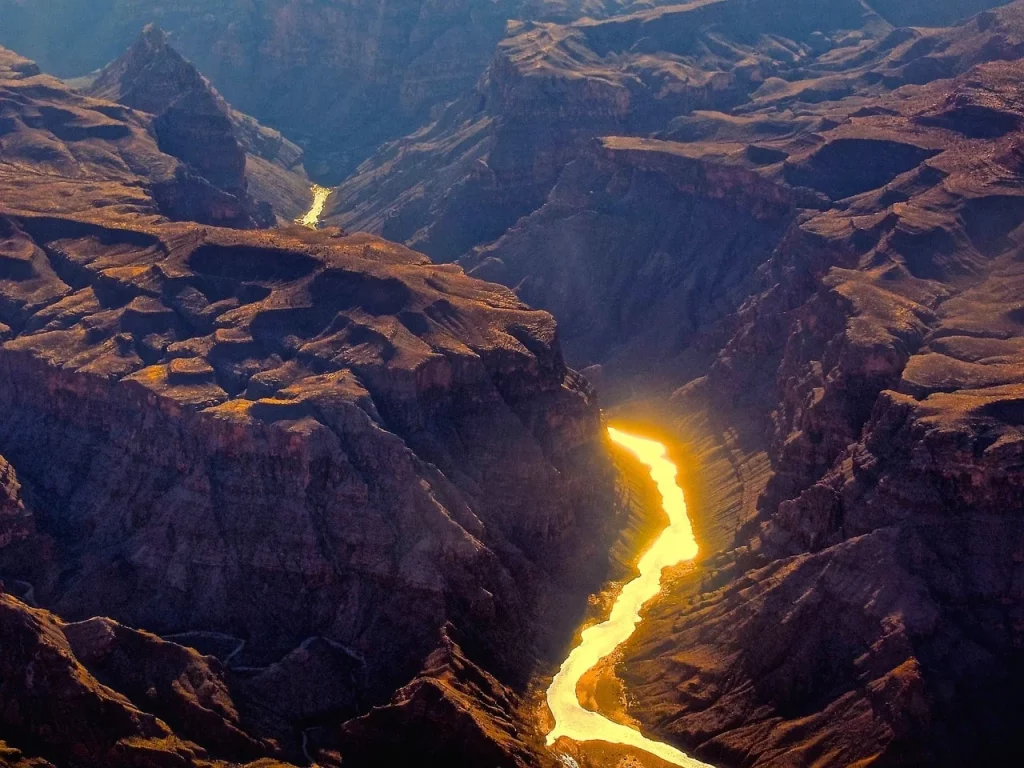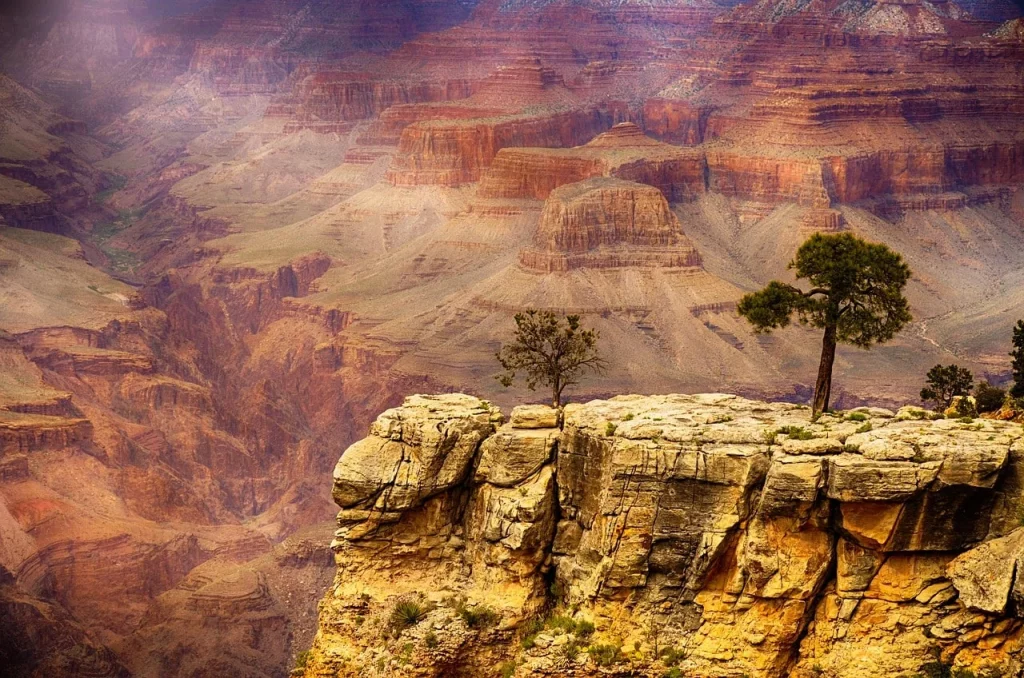Imagine standing at the edge of a vast chasm, where the echoes of an ancient earth whisper secrets through the wind. This is the Grand Canyon, a marvel that stretches beyond the grasp of time and imagination.
In this article, we’ll explore some astonishing facts about the Grand Canyon, delving into its majestic beauty, rich history, and the myriad mysteries it holds. Each fact is a piece of a grand puzzle, painting a picture of a natural wonder that has captivated hearts and minds for centuries.
The Grand Canyon is the living symbol of our nation’s natural majesty and the unyielding power of nature.
Barack Obama
Grand Canyon Facts
Welcome to the world of the Grand Canyon. Pay close attention, as each fact is important to master the quiz I created for you at the end of this article. It’s your chance to showcase your expertise on this natural wonder.
- Arizona, USA, is the location of the majestic Grand Canyon.
- Designated as a UNESCO World Heritage Site in 1979, it boasts immense historical significance.
- This natural wonder stretches over 277 miles (446 km) in length.
- Its width ranges from 4 to 18 miles (6.4 to 29 km), showcasing its vast expanse.
- At its deepest, the canyon plunges over 6,000 feet (1,800 meters).
- The Colorado River played a pivotal role in its formation through erosion.
- From a geological perspective, the canyon reveals ancient layers up to 2 billion years old.
- About 1,000 plant species thrive in this environment.
- It’s a habitat for over 500 species of animals, making it a biodiversity hotspot.
- Listed among the Seven Natural Wonders of the World, its grandeur is globally recognized.
- Human presence in the Grand Canyon region dates back at least 11,000 years.
- The first European explorer to witness the Grand Canyon was García López de Cárdenas in 1540.
- Preservation efforts by President Theodore Roosevelt played a crucial role in its conservation.

- Established in 1919, the Grand Canyon National Park is a testament to natural beauty.
- As one of the most frequented national parks in the U.S., it attracts numerous visitors annually.
- Supai Village is noted for being one of the most isolated communities in the continental U.S., nestled within the canyon.
- The area is known for some of the purest air in the United States.
- Havasu Falls, an iconic waterfall, is situated within the canyon.
- Accessible only by mule, foot, or raft, Phantom Ranch lies at the bottom of the canyon.
- The remarkable Grand Canyon Skywalk, a glass bridge, extends 70 feet beyond the canyon edge.
- Since 1996, California condors, a species at risk, have been reintroduced in the canyon.
- The dominant rock types in the canyon include sedimentary formations like limestone, sandstone, and shale.
- Rafting adventures on the Colorado River are a popular activity for visitors.
- The Pueblo people hold the Grand Canyon sacred, adding to its cultural significance.
- With over 4,800 archaeological sites, the park is rich in historical artifacts.
- The Coconino Sandstone layer reveals ancient reptilian and amphibian tracks.
- Diverse elevation levels in the canyon contribute to its varied climate and biodiversity.
- Temperatures at the canyon’s base often exceed those at the rim by over 30 degrees.

- One of its notable geological features is the Great Unconformity.
- The historic Kolb Studio, now an art gallery and landmark, once served as a photography studio.
- Since 1905, El Tovar Hotel has stood as a historic accommodation on the South Rim.
- Its formation is closely linked with the uplift of the Colorado Plateau.
- A rich fossil record is present, including relics of ancient marine life.
- Native tribes such as the Hopi and Navajo are deeply connected to the land.
- The South Rim is renowned for its accessibility and popularity among visitors.
- In contrast, the North Rim sees fewer visitors due to its relative inaccessibility.
- Trails like the Bright Angel Trail provide breathtaking scenic views.
- Rim-to-Rim hikes present a challenging journey through diverse ecosystems.

- Geologists and ecologists frequently conduct research in the canyon due to its unique features.
- The park is home to wildlife such as mule deer, elk, bighorn sheep, and mountain lions.
- The Grand Canyon Railway offers a historical journey to the South Rim.
- In winter, the North Rim is inaccessible, closed off by heavy snowfall.
- The Yavapai Museum of Geology provides insightful exhibits on the canyon’s geological aspects.
- Its immense size makes the canyon visible even from space.
- The Inner Canyon features arid, desert-like conditions, contrasting with other areas.
- Grand Canyon Village serves as a central hub of activity on the South Rim.
- Ancient archaeological sites along the Colorado River corridor date back thousands of years.
- Indian Garden, located on the Bright Angel Trail, is a favored rest stop for hikers.
- Rock squirrels are among the most frequently encountered animals by visitors.
- The Hermit Formation is characterized by layers of red siltstone and shale.
Grand Canyon Myths

In our quest to fully appreciate it, it’s vital to sift through the myths and measure them against the facts. This section will do just that, ensuring our understanding of the canyon is as grand as the landscape itself.
- The Grand Canyon was formed by the Colorado River in a few thousand years
Geologists have determined that it was formed over millions of years. The Colorado River began carving out the canyon around five to six million years ago. The process involved erosion, plate tectonics, and volcanic activity, leading to the stunning landscape we see today. - The Grand Canyon is the deepest canyon in the world
While it is incredibly vast and one of the most famous, it’s not the deepest. Yarlung Tsangpo Grand Canyon in Tibet holds that record. The Grand Canyon is about a mile deep, whereas the Yarlung Tsangpo reaches depths of over 17,000 feet. - The Grand Canyon only has natural inhabitants
Human history in the Grand Canyon dates back thousands of years. Native American tribes, like the Pueblo people, have lived in and around the canyon for centuries. Their cultural artifacts and dwellings are part of the rich human history that complements the canyon’s natural history. - It’s illegal to take rocks from the Grand Canyon
It is indeed illegal to remove natural objects, including rocks, from the Grand Canyon. This law helps preserve the natural beauty and geological integrity of the park. Visitors are encouraged to take only photographs and leave only footprints. - The Grand Canyon has a uniform climate
It experiences a wide range of climates due to its vast size and varying elevations. The North Rim is cooler and receives more precipitation, while the Inner Canyon has a desert-like environment with extreme heat in the summer and mild winters.
No products found.
Grand Canyon Quotes

The Grand Canyon, a marvel of nature’s artistry, has long captivated the hearts and imaginations of those who witness its majestic beauty. Here is a list of my favorite quotes about it. If you also know some, just post them in the comments so I can add them to the list.
In the Grand Canyon, Arizona has a natural wonder which is in kind absolutely unparalleled throughout the rest of the world.
Theodore Roosevelt
Theodore Roosevelt, the 26th President of the United States, highlighted the unique and unparalleled nature of the Grand Canyon as a global marvel during his presidency.
There’s not a single person in Arizona today who would say the Grand Canyon was a mistake.
Stewart Udall
Stewart Udall, a former U.S. Secretary of the Interior and congressman from Arizona, humorously remarked on the universally acknowledged magnificence of the Grand Canyon.
The elements that unite to make the Grand Canyon the most sublime spectacle in nature are multifarious and exceedingly diverse.
John Wesley Powell
John Wesley Powell, an American explorer known for his 1869 expedition of the Colorado River, described the Grand Canyon’s overwhelming beauty as a convergence of diverse natural elements.
It’s always been a luxury to be able to hop a plane to Paris, to Venice, to the Grand Canyon.
Nancy Gibbs
Nancy Gibbs, a well-known American journalist and essayist, referred to the luxury and privilege of being able to travel to extraordinary places like the Grand Canyon.
The Grand Canyon is carven deep by the master hand; it is the gulf of silence, widened in the desert; it is all time inscribing the naked rock; it is the book of earth.
Donald C. Peattie
Donald C. Peattie, an American naturalist and author, poetically described the Grand Canyon as a monumental work of nature, a silent chasm in the desert, and a record of time itself etched into rock.
Grand Canyon FAQ

You’ve just journeyed through a collection of quotes capturing the Grand Canyon’s majesty. Up next is the FAQ section, the last step before the exciting quiz. Pay close attention to these details for a successful quiz result.
- How was the Grand Canyon formed?
It was primarily formed by the erosive power of the Colorado River over millions of years. This process was aided by the region’s unique geology, consisting of different layers of rock, each with its own characteristics. Erosion by water, wind, and ice, along with the earth’s tectonic movements, gradually carved out this magnificent landscape. - Does the Grand Canyon require reservations?
While the Grand Canyon National Park itself does not require reservations for entry, certain activities and accommodations within the park might. For example, staying at the lodges or campgrounds, participating in guided tours, or hiking in specific areas like the Havasu Falls often require advance reservations due to high demand. - What is the best time of year to visit the Grand Canyon?
The best time to visit it largely depends on your preferences for weather and crowd size. Spring (April to June) and fall (September to November) offer mild weather and relatively fewer visitors. Summer (July to August) is warmer and more crowded but offers longer daylight hours for activities. - Are there any endangered species in the Grand Canyon?
Yes, the Grand Canyon is home to several endangered species. These include the California condor, one of the world’s largest birds, and the humpback chub, a fish native to the Colorado River. Conservation efforts are ongoing to protect these and other species within the park. - Can you raft through the Grand Canyon?
Absolutely! Rafting through it is a popular adventure activity. There are various rafting trips available, ranging from a few days to over two weeks, navigating through the Colorado River’s rapids and calmer stretches. It’s an exhilarating way to experience the canyon’s natural beauty, but make sure to plan well in advance as these trips can book up quickly.
No products found.
Grand Canyon Trivia

Embark on this Grand Canyon quiz! Miss all the answers, and you’ll be metaphorically stranded without a paddle in the Colorado River!
Conclusion
As we conclude, let’s remember that the Grand Canyon is not just a destination but a continuous story of geological artistry. This colossal rift in the Earth’s crust serves as a humbling reminder of nature’s grandeur.
Let’s finish our epic exploration with a funny question: If you had to organize a party at the Grand Canyon, which rock layer would you choose as the VIP section? Let me know in the comments.
5 Sources Used For This ArticleGRAND CANYON NATIONAL PARK GUIDE 2023 – Park Ranger John
The Grand Canyon: Facts, History & Profile – Info Please
The Best Time to Visit Grand Canyon – Raom And Thrive
9 Interesting Animals in the Grand Canyon – Cool Wood Wildlife Park


